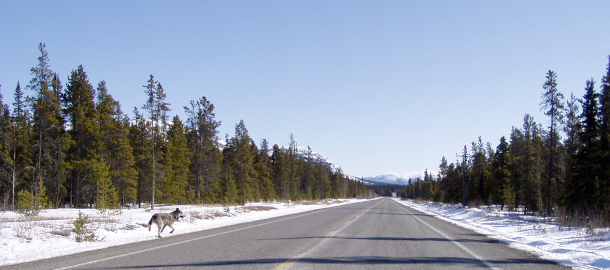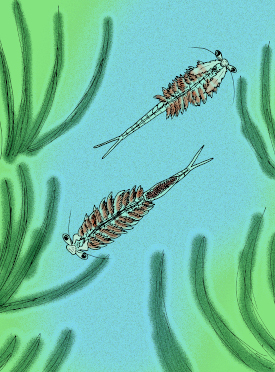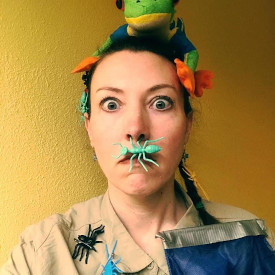‘It Could Be the Last One’: Stories of People Helping Rare Critters
Air Date: Week of December 31, 2021

A wolf crosses the highway in Whitehorse, Yukon. (Photo: Joseph, Flickr, CC BY-SA 2.0)
As an endangered species advocate, Tierra Curry gets calls and emails from strangers across the country who think they might have found the very last plant or animal of a particular rare species. She shares some of the most humorous and heartwarming stories with Jenni Doering, as well as a story about her own breathtaking encounter with a wolf in an Alaskan snowstorm.
Transcript
BASCOMB: It’s Living on Earth, I’m Bobby Bascomb.
DOERING: I’m Jenni Doering.
O’NEILL: And I’m Aynsley O’Neill.
We continue our holiday special now with some more animal stories. Jenni, what do you have for us?
DOERING: Yeah, I talked with Tierra Curry, she is a senior scientist with the Center for Biological Diversity. Today she mostly has a desk job, working towards getting legal protection for endangered species, plants and animals but she started by telling me about a close encounter she had a while back working with animals in Alaska.
CURRY: I want to go back to about a decade ago when I lived in Alaska. I was volunteering at a wildlife rehabilitation center that focused on birds. And because Alaska is such a wild place, we would get bald eagles in regularly, so I got to work with them pretty much on a daily basis. And just getting to know so many different bald eagles, I came to understand that they even looked different, and they had different personalities. And it kind of changed the way that I think about wildlife. Because it just made me realize that we think of wild animals as, like, all the ones in a group being the same, but they're all different. They have their lives and their personalities, and you know, their schedules. And so at the clinic, some of the bald eagles were very shy and they would, like, never interact with us. And some of them were really mad to be there. And they just, like, wanted to attack us. And some of them were just very kind and cooperative. And one of the amazing experiences that I had at that clinic is after the birds were feeling better, they went out to a flight center to work up their strength and learn to fly again before they were released into the wild. And so, one winter morning, it was my job to take two bald eagles in really large dog kennels out to this flight center. And there happened to just be a huge blizzard that day. And in Anchorage, when there's a blizzard, your life doesn't shut down, you just keep going. And so you just go out on the road and try to make a lane and hope for the best. And so I was driving to this Flight Center with the two bald eagles in my backseat, which was cool enough, but I kept having to get out of the car and chink the ice off my windshield wipers. And because this was my first winter in Alaska, I didn't even really have an ice scraper. So, I'm embarrassed to say this, but I was using a credit card. I'm just like stuck there with my head down, it's pouring snow, I'm sure my hair's freezing and, and I look up and there's a wolf at the edge of the woods, just looking at me. And I stared back at it. And it was just this moment where I was hyper aware of being a human. I'm here, at this moment, on a Tuesday morning, outside Anchorage. And this wolf is here too. And we just stared at each other and shared this moment. And we're both dealing with the snow, it was having trouble walking, it kept postholing and, like, having to push against the snow with its chest. And we were both surprised by the encounter. And then we both just went on about our schedules after that moment, but it's a moment that I'll, I'll just never forget.
DOERING: Hmm. Was that the first time that you had seen a wolf?
One of the wolves spotted by Tierra on the side of the road in Denali. (Photo: Courtesy of Tierra Curry)
CURRY: You know, I'd seen wolves in Denali on a tour bus with lots of other people. We saw, like, 12 wolves in one day at the very end of fall when all the animals are active and trying to put on weight for the winter. And I'd seen them at a distance in Yellowstone but to just run into one in the course of the morning and have this moment with it, just me and the wolf, in this terrible weather. It was, it was amazing.
DOERING: So Tierra, I'm sure your job at the Center for Biological Diversity has brought you some pretty neat wildlife encounter stories. Would you like to share some of those with us?
CURRY: I would. One of the best parts about my job, the most interesting parts, for sure, I work on endangered species around the whole country, but at the policy level. So I'm usually just, like, behind my desk working on policy documents. But because of this, I work on all kinds of species across the country, from crayfish to butterflies to the Humboldt martens, just whatever is endangered and needs help if it's a plant or an animal. And people contact me regularly when they have an experience with one of these animals. Like, if someone has a monarch butterfly that they've watched grow from a caterpillar and it isn't doing what they think it should be doing, they contact me for advice. That ranges from "my monarch lacks self confidence" to, like, it's the wrong color, or should I help it out of its shell. Or one time somebody found me because their dog was down in the creek and came back with a blue crayfish attached to its lip. And they had heard on the news that there was this endangered blue crayfish and so they wanted to see if their crayfish that their dog brought home was endangered and what they should do about it. I sent the pictures to crayfish researchers in that state and it actually was a species that we had petitioned for protection for and this ended up being a new location for it. But in terms of the immediate, I told them just to put it back in the creek, but the researcher was really glad to have the information about a new population of it. Kind of the most touching of these stories, one time, there was a fairy shrimp in Florida called the Florida fairy shrimp and we petitioned for protection for it, and the Fish and Wildlife Service said that it was extinct.

An artist’s rendering of the Florida fairy shrimp, which was declared extinct when the pool that contained the entire known population was destroyed for construction work. (Photo: Apokryltaros, Wikimedia Commons, CC BY-SA 4.0)
And so that was hard and we put out a press release about the Florida fairy shrimp being gone. And then, this woman a couple months later, the roads around her house flooded and she found a bunch of fairy shrimp on the road. And she thought that maybe these fairy shrimp were the Florida fairy shrimp and she didn't know what to do. So she contacted me and I told her to contact somebody local, you know, to see what they were. And she just went out of her way. She contacted the state Wildlife Commission, a local Marine Lab. Upon their advice, she went and bought a tank and like food to feed them. She just wanted so desperately to help these fairy shrimp. And she felt so much responsibility, because beyond compassion for the individual animals, she was afraid they were going to get run over, or that vector control was going to spray for mosquitoes and that it would kill them. She felt responsibility for the fate of the entire species. What if she had found this animal that was just declared extinct. And for days, it took over her life, she dropped, like, everything she was doing to try to take care of these fish shrimp to see if she could save the species. And I was just so touched, and I felt so helpless, but also so grateful to her, like, faced with this urgency and feeling the meaningfulness of the moment. And I think that, like, a lot of people, they hear about the extinction crisis, and they want to help and they want to be a good human being and do the right thing. And then they encounter this really rare animal that could be the last of its kind and they don't know what to do, and somehow they find me.
DOERING: So, Tierra, were those fairy shrimp that this woman spent three days of her life agonizing over, were they ultimately you know, this extinct species?

Tierra (second from the left) and her colleagues at the Center for Biological Diversity held a memorial service for the Florida fairy shrimp and a subspecies of rainbow snake in 2011. (Photo: Courtesy of Tierra Curry)
CURRY: No, they ended up being the common species of fairy shrimp in that area. But they could have been! So it's really important that when people do have these encounters, they report it to someone who could help save them because it's entirely possible that it's just something that researchers didn't find, and that you could find it. And most of the time, the answer is just like, leave the animal where it is, it'll be fine. But it's an honor for me to get to talk to people who are having these intense experiences. But sometimes, it's not so good. Sometimes people just kidnap stuff that they shouldn't kidnap.
DOERING: What did they do?
CURRY: Well, one time I got an email that was titled, my pika won't poop.
DOERING: [LAUGHS]
CURRY: Pikas are little, rabbit-like animals that live on talus slopes in the west, and they squeak.
[PIKA SQUEAK SFX]
CURRY: Like, if you've ever been hiking in the high mountain west and you hear a little squeak it's probably a pika.
[PIKA SQUEAK SFX]
CURRY: But anyway, I got this email one day called my pika won't poop and I just think oh, no. And I opened it, and someone had brought home a pika. It hadn't eaten or pooped for days and they didn't know what to do. And so of course, I told them, take the pika back.

Tierra Curry, here dressed as a wildlife biologist for an amusing work-from-home video call, is a Senior Scientist with the Center for Biological Diversity. (Photo: Courtesy of Tierra Curry)
DOERING: Yeah, I really hope they did. I mean, it can't be good for the pika. So Tierra, if someone at home listening to this does find some critter that they think maybe is an endangered species, or you know, we thought it was extinct. What would you recommend that they do?
CURRY: In general, just take a picture, take a bunch of pictures of it, don't disturb it. If it is in danger of getting run over, or getting sprayed by vector control, like those were kind of extenuating circumstances for the fairy shrimp. Mostly just take the pictures so that you can contact the researcher or contact me and I can find the researcher to find out what it is. Most of the time unless an animal is hurt, even if it is hurt. Probably don't pick it up. Just contact somebody who has the skills to go pick it up.
DOERING: Well, thank you so much for sharing these wonderful stories, Tierra.
CURRY: Thanks, Jenni. Take care.
Links
The Center for Biological Diversity’s Saving Life on Earth Campaign
Living on Earth wants to hear from you!
Living on Earth
62 Calef Highway, Suite 212
Lee, NH 03861
Telephone: 617-287-4121
E-mail: comments@loe.org
Newsletter [Click here]
Donate to Living on Earth!
Living on Earth is an independent media program and relies entirely on contributions from listeners and institutions supporting public service. Please donate now to preserve an independent environmental voice.
NewsletterLiving on Earth offers a weekly delivery of the show's rundown to your mailbox. Sign up for our newsletter today!
 Sailors For The Sea: Be the change you want to sea.
Sailors For The Sea: Be the change you want to sea.
 The Grantham Foundation for the Protection of the Environment: Committed to protecting and improving the health of the global environment.
The Grantham Foundation for the Protection of the Environment: Committed to protecting and improving the health of the global environment.
 Contribute to Living on Earth and receive, as our gift to you, an archival print of one of Mark Seth Lender's extraordinary wildlife photographs. Follow the link to see Mark's current collection of photographs.
Contribute to Living on Earth and receive, as our gift to you, an archival print of one of Mark Seth Lender's extraordinary wildlife photographs. Follow the link to see Mark's current collection of photographs.
 Buy a signed copy of Mark Seth Lender's book Smeagull the Seagull & support Living on Earth
Buy a signed copy of Mark Seth Lender's book Smeagull the Seagull & support Living on Earth

